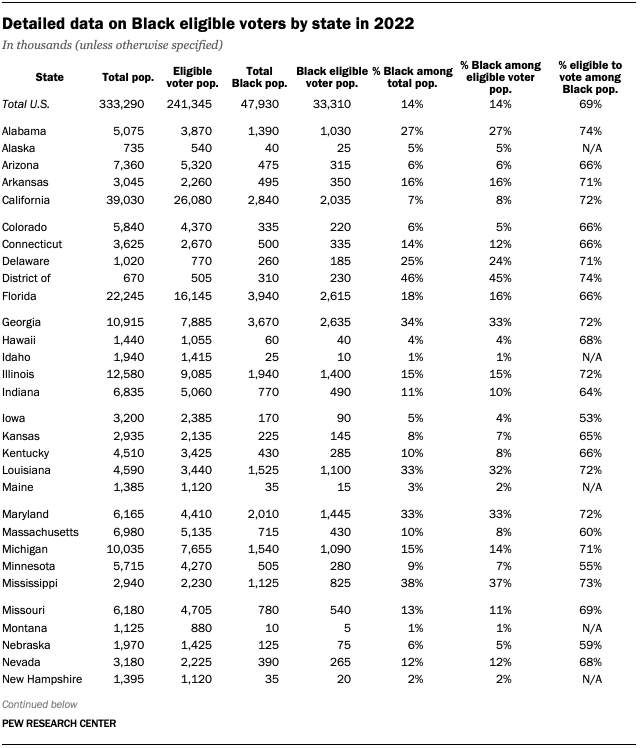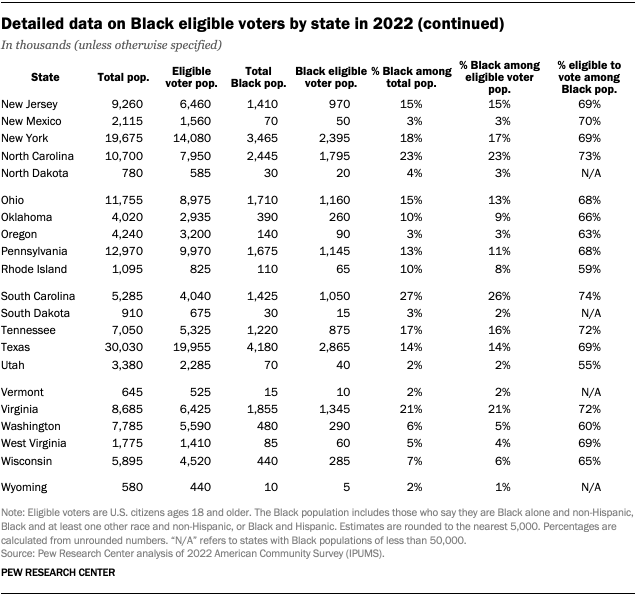The number of Black eligible voters in the United States is projected to reach 34.4 million in November 2024 after several years of modest growth. And Black eligible voters stand out for turnout rates that are higher than among Latino and Asian eligible voters.
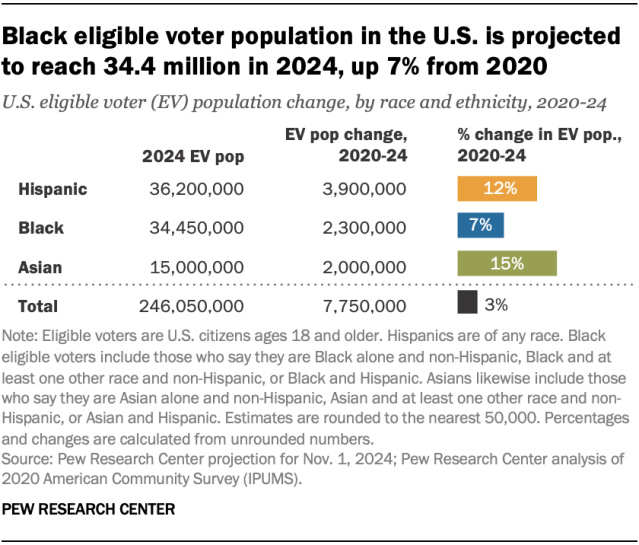
Black voters could play an important role in determining the outcome of key 2024 elections, including for U.S. president. In Georgia, a closely watched swing state, Black Americans account for a third of eligible voters.
In 2020, 92% of single-race Black, non-Hispanic voters cast a vote for Democrat Joe Biden, while only 8% backed Republican Donald Trump, according to a Pew Research Center analysis of validated voters.
Ahead of the 2024 presidential election, here are five key facts about Black eligible voters in the U.S., based on our own projections for 2024, as well as Census Bureau data for earlier years. (Eligible voters in this analysis are defined as citizens ages 18 and older residing in the 50 states and the District of Columbia. Not all eligible voters are actually registered to vote. Detailed demographic information about Black eligible voters is available in the drop-down box at the bottom of this post.)
How we did this
This post is one in a series that explores the eligible voter population in the United States in 2024. For this analysis, we examine the detailed demographics and geographic distribution of Black Americans who were eligible to vote in the U.S. in 2022, with projections of the eligible voter population in November 2024.
“Eligible voters” refers to U.S. citizens ages 18 and older. The analysis focuses on persons living in the 50 states and the District of Columbia. In this analysis, Hispanics are those who self-identify as Hispanic or Latino and can be of any race; the Black and Asian populations include persons identifying with only one race, more than one race and both Hispanics and non-Hispanics.
The analysis is based on data from the U.S. Census Bureau’s American Community Surveys from 2022, 2020, 2016, 2012 and 2008, and the 2000 U.S. decennial census provided through Integrated Public Use Microdata Series (IPUMS) from the University of Minnesota.
Projections for November 2024 are based on population projections by race, Hispanic origin and nativity developed by the Census Bureau together with data from the American Community Surveys (IPUMS) of 2010-2022. Projected values of the share who are U.S. citizens by age are based on trends drawn from the 2010-2022 American Community Surveys (IPUMS).
Read other posts in this series
Black Americans are projected to account for 14.0% of eligible voters in the U.S. in November, according to Pew Research Center projections. The percentage of eligible voters who are Black has risen slowly in the past two decades. In 2012, for example, Black voters represented 13.2% of all eligible voters. In the last U.S. presidential election in 2020, they represented 13.5%.
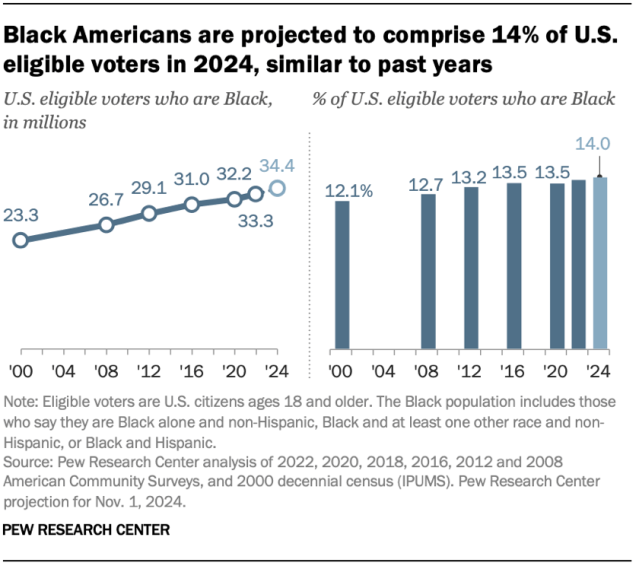
At the same time, the number of Black eligible voters has grown steadily. Between 2020 and 2024, that number has grown by an estimated 7.1%, a slower rate than among Asian eligible voters (15.3%) or Hispanic eligible voters (12.1%).
As of 2022, about half of Black eligible voters live in one of eight states. Texas has the largest number, with 2.9 million, followed by Georgia and Florida (2.6 million each). Rounding out the top eight are New York (2.4 million), California (2.0 million), North Carolina (1.8 million), and Maryland and Illinois (1.4 million each). Together, these states account for 52% of Black eligible voters in the 50 states and the District of Columbia.
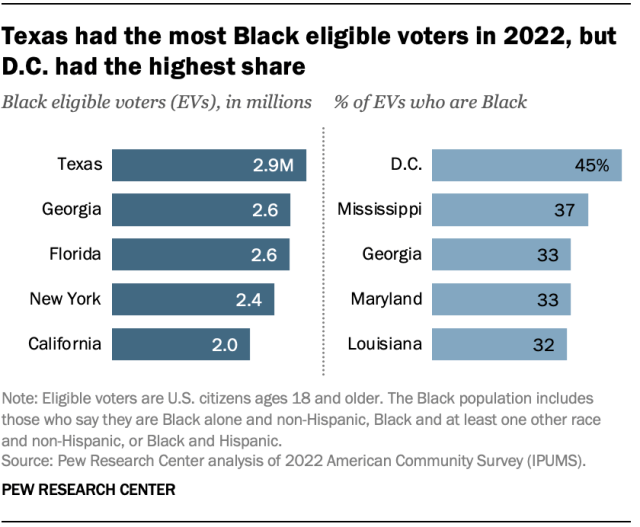
Black voters made up nearly half (45%) of all eligible voters in the District of Columbia in 2022, a higher share than in any state. Other places with large shares of Black eligible voters are Mississippi (37%), Georgia (33%), Maryland (33%) and Louisiana (32%).

Regionally, more than half of Black eligible voters (57%) live in Southern states. The Midwest (17%) and Northeast (16%) have the next-highest shares of the nation’s Black eligible voters, while relatively few live in the West (10%).
About seven-in-ten Black people in the U.S. are eligible to vote, a higher share than among Hispanics and Asian Americans. Black Americans are more likely to be eligible to vote than some other groups because a high share are ages 18 and older (73%) and an even larger share are citizens (96%).
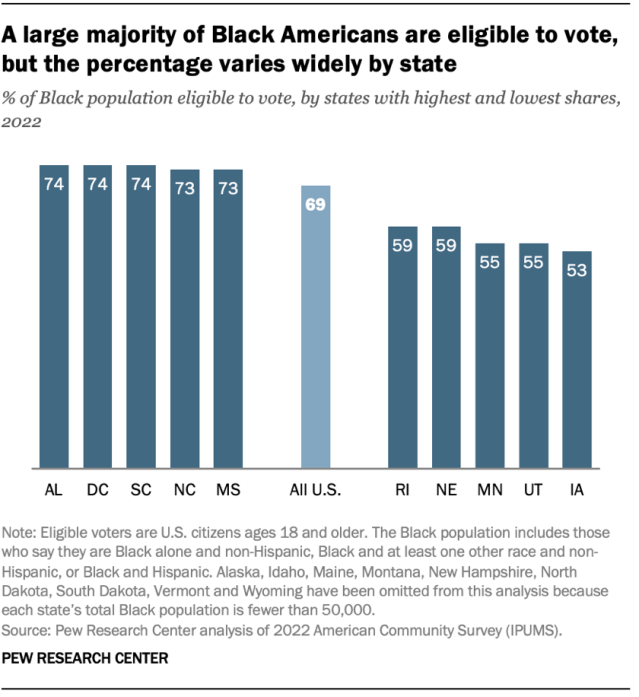
Nevertheless, the share of the Black population that is eligible to vote varies considerably by state. While 74% of all Black residents of Alabama, D.C. and South Carolina are eligible to vote, fewer than six-in-ten are eligible in Minnesota (55%), Utah (55%) and Iowa (53%).
Black eligible voters differ from the overall population of eligible voters by age, education and other factors.
Around one-in-four Black eligible voters (23%) have a bachelor’s degree, lower than the share among all U.S. adults eligible to vote (33%). Another 34% of Black eligible voters have some college education or an associate degree. The remaining 43% have a high school diploma or less, compared with 36% of all eligible voters.

Black eligible voters are more likely than eligible voters to be women (53% vs. 51%). They also tend to be younger than eligible voters overall: 60% of Black eligible voters are under the age of 50, compared with 52% of all U.S. eligible voters.



